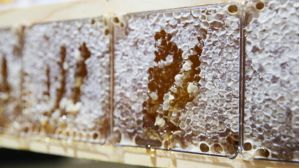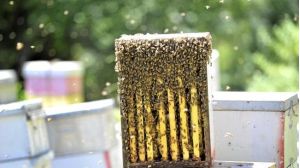
SANDRA Ullrich loves bees. She really. Loves. Bees.
To hear the nursing lecturer-cum-apiarist talk about her furry yellow charges is to hear a woman besotted.
Ullrich literally talks to her bees, introducing herself as she approaches each hive.
“Hi darlings, it’s just me,” she says as we lift the lid on one of three urban hives perched on top of the Goyder Pavilion at the Adelaide Showground.
“And this is Nathan and Dylan,” she continues, pointing to me and my photographer.
I’m dressed head to toe in a white beekeeper’s suit, complete with a veil to protect my face, but as the insects begin to buzz around my head I have to fight every instinct to run away.

It’s not an uncommon reaction – these little guys pack a nasty punch after all – but according to Ullrich the public attitude to bees is changing as people realise just how important the insects are to the globe.
Around the world bees are in trouble. Varroa mite infestations, colony collapse disorder where workers abandon their queen, the impact of pesticides and global warming are all putting the insects under unprecedented pressure.
Scientific opinion differs on exactly what a world without bees would look like, with predictions ranging from a noticeable drop in food output to a complete collapse of agriculture and the extinction of the human species. Naturally, nobody’s particularly keen to find out which scientists are right.
That’s where people like Ullrich come in. The founder of Adelaide Bee Sanctuary is an evangelist – a bee-vangelist if you like – who has made it a life goal to change people’s opinions on bees. Not only shouldn’t we fear bees, we should love them, Ullrich says, embrace them as not only plant pollinators and honey producers but as complex creatures with real lessons to impart to humanity.

Ullrich is the founder of Adelaide Bee Sanctuary, a collective that relocates homeless swarms from backyards to hives across the city and Hills. She has installed hives at Government House, Archbishop House, Adelaide Zoo, Adelaide Showground and other high-profile locations, as well as in orchards, community gardens and back yards.
The German-born, South Africa-raised apiarist moved to Australia as a child in the early 1980s and says her love of insects and other small creatures has been with her for as long as she can remember.
“I’m a tender and a saver,” Ullrich says after tending to more of her hives at the Fern Ave Community Garden in Fullarton.
“I tend to ants, to worms. I won’t kill a spider, I’ll put it outside. I’ve always been fascinated by the little things. It’s always been there, and I guess beekeeping is an extension of this.”
Ullrich came to beekeeping through a dinner party at a friend’s house in the country.
“He showed me his dam with fish in it, he showed me his finches, then he said, ‘would you like to see my beehives?’” she says. While the other guests ate, Ullrich stayed outside watching the hives, fascinated by their order and complexity. It quickly became an obsession, and the lap swimming she once used to manage stress was replaced by beekeeping. She says this meditative aspect to keeping bees is one of the great lessons for an increasingly busy world.

“You have to come to bees quite considered and quite calm, so there’s a mindfulness to it,” Ullrich says.
“If you’re angry or frustrated, they respond in kind. They pick up on that.
“I get the biggest thrill. My partner Richard goes for motorcycle rides in the Hills – I get the same thrill from my bees.
“They do speak to me. They teach me a lot. You can get quite academic about it, and the more I read the less I know. Beekeeping has such a breadth and depth to it.
“You can be very bee-centric and get into the shamanism and spirituality around beekeeping.”
Ullrich started out with three adopted swarms, then in the summer of 2013-2014 she collected 19 more from backyards or anywhere else they were unwanted.
“Then I had 40 hives, and now I have more than that,” she says.
“The large majority are in the Hills, but I have a number around the city.”
Ullrich maintains and insures the hives, and the hosts pay a nominal installation and annual maintenance fee. Any harvested honey is shared between the hive host and Ullrich, who has teamed up with chef Simon Bryant to market the liquid gold through his dirt(y) label. Any profits help fund the sanctuary.

The idea of having hives full of bees in public places might seem unlikely in this age of litigation and occupational health and safety, but Ullrich says attitudes have changed markedly in recent years.
“The City of Charles Sturt, for example, flipped its risk management project on its head,” she says.
“That council actually pays for hives to be in various locations. There’s one at the Henley Beach Community Garden, and the Findon Community Centre is getting one very soon.”
Ullrich says the fact that parents were happy for their children to sit next to the beehive she recently installed at Government House was indicative of a growing love of bees. “At Government House I had children sitting right near the hives, picking up the male drone bees – they have no stingers,” she says.
“People are much more educated and it’s just wonderful to see. There’s still some fear, but more and more the public sentiment is changing. I really want to thank the people of Adelaide – they ring up when they have bees in the yards and they say ‘we really don’t want these bees destroyed’.”
Honey month
Central Coast Bee Keepers club spokeswoman Barbara Elkins shares her love of bees during 'honey month'.
- May 24th 2016
- 6 months ago
Ullrich says there are many things South Australians can do to help care for bees and our “wonderful beekeeping industry”, but top of the list was being aware of the chemicals used in the garden.
Neonicotinoids, a family of chemicals used in a number of common garden products such as Confidor, has been implicated in colony collapse disorder.
“Neonicotinoids pass through our system beautifully, but over time there’s a sub-lethal threshold that builds up in the hive,” Ullrich says.
“Every generation of bees that goes out to pollinate plants that have been treated with neonicotinoids will bring it back to the hive. One day you’ll have your field bees going out and they just won’t come back because they’ve lost their way.”
Ullrich says gardeners shouldn’t make the mistake of blaming agricultural practices for the build-up of potentially harmful chemicals.
“The concentrations are actually higher in our urban areas,” she says. “Why do we need these chemicals in our yards? Pull out the goddamn weeds! Enjoy it! If you saw a beehive where the bees have died because they foraged on something that they had sprayed in their garden – it is devastating.”
What's Killing Our Bees?

Bill Turnbull investigates one of the biggest mysteries in the countryside: what is killing the bees? It is a question that generates huge controversy. Changes in the weather, pesticides and even a deadly virus have all been blamed.
- October 30th 2015
- a year ago
Thinking about the honey you purchase and avoiding imports is another good way to care for the local industry, Ullrich says.
“Raw natural honey that’s unfiltered crystallises,” she says. “It hardens like a brick – you could throw it through your kitchen window. That’s good honey.
“We’ve become familiar with honey that is runny, but you just pop your tub in some warm water and let it soften up.
“Buy local and support your local beekeepers.
“We’ve got Gilbert Beekeeping, Miranda from Flinders Ranges Apiary, Hayes Honey, Mademoiselle Bee – so many good beekeepers.”
Adelaide Bee Sanctuary is now branching out into work with people with learning difficulties, mental illness and the homeless, and Ullrich says they’re always keen to speak with potential corporate sponsors who can help them fund their work.
“It’s a great green image for sponsors, and they can get some honey, too,” she says.
But at the end of a busy day tending hives, working with sponsors and spreading the bee gospel, Ullrich is confident that she has the best de-stressing regime on earth.
“You can put your chair out there near your hives and tell the bees your secrets, and they’ll tell you theirs,” she says. “They make me very happy.”
adelaidebeesanctuary.com.au Sandra will be at Fern Ave Community Garden today between 11am and 3pm. facebook.com/FernAvenueCommunityGarden
IT’S SWARMMING SEASON!
If you see a honeybee swarm you can call Adelaide Bee Sanctuary on 0412 967 991.
“Don’t panic, just leave them be,” Sandra Ullrich says. “Don’t spray them with water or burn them. The bees are at their most vulnerable at this time and just want to protect their lovely queen and find a new home as soon as possible.
“Conduct a visual inspection of the outside of your house and block any air vents, especially at the beginning of spring when swarming is at it heaviest.”
CARING FOR THE BEES IN YOUR GARDEN
Historically, our cities have provided a wonderful source of bee forage and honey flows.
In the early 1880s there were about 200 beekeepers in the Adelaide metro area.
Cities all over the world
are embracing beekeeping and greater awareness of how we can cultivate a “pollinator friendly” garden is growing.
Planting pollinator friendly gardens, ornamental and productive, can contribute to the productivity of your garden.
The home gardener can:
■ Plant bee-attracting plants that provide a mix of pollen and nectar, and which bloom during the entire season, particular in autumn and winter.
■ Use a range of colours and plant flowers in clumps.
■ Select low maintenance plants that are drought-tolerant such as native plants.
■ Set your mower to high to allow for bee forage plants such as clover and dandelions.
■ Don’t use pesticides – get back to nature and pull weeds by hand.
■ If you absolutely must use pesticides apply after dark when our important pollinators are less active.
■ Leave some areas mulch-free and undisturbed to provide habitat for our ground nesting bees.
■ Provide a bee bath with pebbles in it and help hydrate our bees during the hot days.
For further information
see the Bee-Friendly: A planting guide for European Honeybees and Australian Native Pollinators by Mark Leech
Nathan Davies, Sunday Mail (SA)





